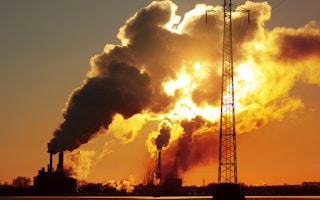Asia could account for more than half of global GDP and about 40 per cent of global consumption by 2040. But the region’s economic growth is founded on coal, and Asia already produces more than half of the world’s greenhouse gas emissions.
It is also one of the most climate-vulnerable regions. The latest Intergovernmental Panel on Climate Change (IPCC) report estimates that Asia is likely to witness 90 to 120 days in a year with temperatures above 35°C in case of 1.5 to 2°C warming and over 180 days in case of 4°C warming.
But Asia’s dependence on coal is likely to continue to grow as the need for energy expands, both to provide energy access to a rising population and in support of the region’s role as the world’s manufacturing hub. Coal use is expected to rise by 81 per cent by 2030, making the region — home to 93 of the 100 world’s most polluted cities — an emissions heavyweight.
South Asian countries are among the most rapidly growing and developing nations globally. These countries represent more than 94 per cent of the total population of the region and the region’s energy consumption is on par, heavily relying on coal.
South Asia is also home to countries with the largest energy access deficits — 152 million people in the region lack access to electricity. Similarly, while Southeast Asia is on a promising path of achieving universal access to electricity by 2030, 45 million people are still without access. For those with access, their demand is being met with fossil fuels.
Decades of exponential economic growth has dramatically propelled China’s energy needs. China is now the world’s biggest consumer of energy, the largest producer and consumer of coal, and the top emitter of greenhouse gases.
Balancing energy demand growth and the need for decarbonisation is complex. According to the IEA estimates, to halt global warming to under 2 degrees Celsius as agreed to in the Paris Agreement, 90 per cent of the growth in energy demand across Asia would need to be fulfilled by low-carbon energy sources and existing high-emitting fossil fuel demands would need to be replaced by 2040.
However, there is an increasing deficit between the region’s existing energy infrastructure and what is required to meet future needs. If we maintain the status quo, energy inequity will deepen further.
Yet, Asia still has time to correct its conventional energy production and consumption. Much of the infrastructure and urban space is yet to be built, giving the region the ability to choose energy solutions that can sustainably meet growing demand.
To prioritise a low-carbon economy, the region needs to set and follow major energy policy goals that ensure universal energy access that is not fossil fuel-dependent and that make significant headway with diversification of the energy mix.
The region is still capable of meeting the IPCC’s goals, by making distributed renewable energy (DRE) a key element of its energy strategy.
Distributed renewables: underestimated potential
DRE can seamlessly fit all kinds of energy needs. There is no limit to the flexibility that DRE brings to energy planning. Mini grids are ideal for communities with a high household density, while solar home systems are ideal for regions with sparsely settled households. A 50 to 100 MW range decentralised generation facility can power a single manufacturing plant.
DRE can also replace the diesel generators which exclusively power small island communities in the Philippines and Indonesia.
As they can be rapidly deployed (a 50 kilowatt solar mini grid serving a single village up to 3 kilometers in radius can be installed in under two months), DRE is an agile facilitator of economic growth.
DRE systems can help rural communities gain access to reliable electricity more quickly, which is critical to powering schools, clinics and hospitals, and other community essentials.
DRE systems such as standalone 3 solar home system (SHS) and renewables based mini grids can speed up rural communities’ access to energy.
Replacing diesel generators and coal-fired grids with renewable alternatives allows us to have a double impact: cutting greenhouse gas emissions now and preventing a further increase in emissions in the future.
Distributed renewable energy projects have underestimated potential to fight the war against climate change because of their size. Irrespective of that, DRE can bring socio-economic benefits of affordable, reliable, and sustainable energy to the continent, creating a strong case for policies, investments, and initiatives to promote deployment.
Every sustainably generated kilowatt-hour of electricity counts when we consider the climate challenge facing the planet, and so energy planning must also compare DRE and fossil fuels on both carbon cost and developmental impact.
For instance, Southeast Asian governments have drawn up a five-year plan to enhance renewable energy capacity and rebuild pandemic-hit economies. ASEAN energy leaders set a target of 23 per cent share of renewable energy in the total primary energy supply by 2025.
Recently, the APEC Economic Leaders have also reiterated their commitment towards tackling climate change by promoting sustainable financing and quality investment. And global institutions are joining The Rockefeller Foundation and IKEA Foundation in championing DRE as a solution to the climate crisis and as means for more rapid and equitable economic development.
It is evident that given the billions that will be allocated to the power infrastructure over the Covid-19 recovery, investment decisions will have a decisive impact on whether the world has a chance of achieving the targets set in the Paris Agreement.
Deepali Khanna is managing director, Asia regional office, The Rockefeller Foundation


















